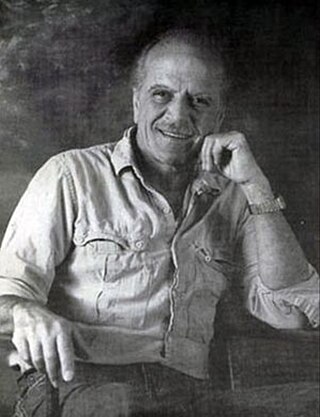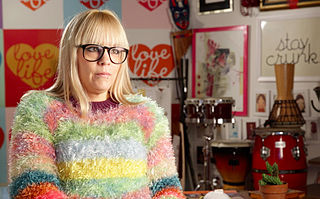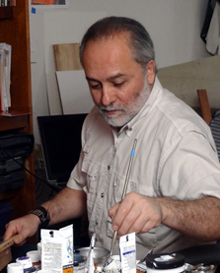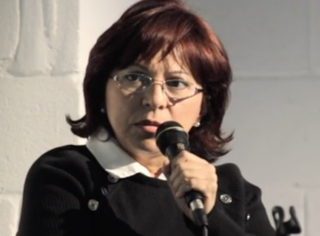
Barbara Nessim is an American artist, illustrator, and educator.

Alejandro Jesús Obregón Rosės was a Colombian painter, muralist, sculptor and engraver.

Rodolfo Abularach was a Guatemalan painter and printmaker of Palestinian descent.

Débora Arango Pérez was a Colombian artist, born in Medellín, Colombia as the daughter of Castor María Arango Díaz and Elvira Pérez. Though she was primarily a painter, Arango also worked in other media, such as ceramics and graphic art. Throughout her career, Arango used her artwork to explore many politically charged and controversial issues, her subjects ranging from nude women to the role of the Roman Catholic Church to dictatorships.
Luis Camnitzer is a German-born Uruguayan artist, curator, art critic, and academic who was at the forefront of 1960s Conceptual Art. Camnitzer works primarily in sculpture, printmaking, and installation, exploring topics such as repression, institutional critique, and social justice.

Paul V Coldwell is an English artist.

Liliana Porter is a contemporary artist working in a wide variety of media, including photography, printmaking, painting, drawing, installation, video, theater, and public art.

Elaine Shemilt is a British artist and researcher especially known as a fine art printmaker.

Tiphanie Brooke, known professionally as Antigirl, is an American multidisciplinary artist and graphic designer, best known for her series of heart paintings, street art and collages.

Alberto Gómez Gómez is a figurative artist, painter and master print maker. Born in Bogotá, Colombia, Gómez Gómez became a citizen of the United States on July 29, 2011. He is best known for producing monumentally scaled murals in the United States and Colombia. His art can also be found in private collections throughout the European capitals of Spain, Belgium, South Africa, Russia, Germany, the United Kingdom, and Italy. His signature style depicts people, figures, and daily life. His works often address spiritual, social, philosophical, historical, and political events and issues, although often in a humorous way.
Delia Cugat is an Argentinian artist who has lived and worked in Paris for most of her professional career, with her partner Sergio Camoreale, also a well-known Argentinian artist). Cugat is one of the founding members of the graphic art group Grabas. Cugat's work encompasses the solitary everyday world of Edward Hopper, the pictorial reflection of Balthus, and the Cubist idea of composition of Jacques Villon. She has her own world of meanings and has established herself as belonging to that of the Latin American greats.
Barbara Zeigler (1949) is a Canadian visual artist with a focus in print media. She has also worked in drawing, video, installation and collaborative public art, often combining these media with her work in print to prompt questions as to the character and consequences of our existing cultural paradigms. Her artwork focuses on the evolving relationship between human culture and the ecosphere, with special consideration given to the ways in which individual and collective identity become evident through land usage. Zeigler lives and works in Vancouver, British Columbia, Canada.

Diana Ordóñez, known professionally as LeDania, is a Colombian multimedia artist based in Bogotá. Known mostly for her graffiti murals, LeDania also works in photography, graphic design, advertising, artistic makeup, and decorative items such as clothing and accessories.

María Evelia Marmolejo is a Colombian radical feminist performance artist, later based in Madrid and New York City. She is credited by the Colombian scholar María Lovino with staging the first work of feminist performance art in Colombia, in 1981. She is best known for discussing controversial themes such as political oppression, feminism, environment, and socioeconomic issues within her performances.
Karen Lamassonne is a Colombian American artist. Throughout her career Lamassonne has explored a plethora of disciplines such as film, printmaking, painting, graphic design, video art, and music. Lamassonne’s work is notable for reflecting this combination of several different studies, most noticeably that of her paintings having a very cinematic vision behind them. Noteworthy works of Lamassonne’s all contain this sense of multifaceted technical skills put into them. A majority of Lamassonne's work contains motifs of sensuality from a woman's perspective, specifically she includes sexuality from her own perspectives and experiences. Moreover, her signature combination of feminine-led sexuality and a frank expression of true life have led to both Lamassonne and her work being the subject of criticism via censorship.

Nirma Zárate Mejía (1936–1999) was a Colombian artist, professor and researcher famously known for her abstract works. Zárate was born in Bogota, Colombia. She grew up in Colombia during World War II. The war had many implications on Colombian lifestyle and politics at the time. Colombia first supported the Axis powers and was in a constant state of shifting between its military powers and societal aspects due to U.S. intervention. Colombia finally shifted to supporting the allies after the Japanese attack on Pearl Harbor. During this time, Colombia was in a severe state of poverty where impoverished children roamed the streets in high numbers and were called gamines. During this time, discrimination and violence from police towards impoverished children were extremely high. Zárate experimented with different mediums and styles such as Abstract Art or Pop Art. Her first exhibition was as a student in Bogota and shortly after, she moved to the United States where she lived for four years. She settled in Washington where she was chosen by Union Panamericana De Washington to participate in an exhibition of great Colombian art. Later in her career, Zárate was one of the co-directors of "Taller 4 Rojo", a collective of Colombian artists interested in representing the political and social reality of Colombia. Her art during this period in her life turned shifted to more politically active art. She also taught at the Universidad Nacional de Colombia for many years. Zárate died in her hometown of Bogotá, in 1999, at the age of sixty-three.
Alicia Barney is a Colombian artist based in Cali who focuses her paintings and installation art on ecological questions and problems such as water pollution, deforestation and quality of life. She specializes in on-hand interactions with her surroundings and what the natural environment has to offer in order to educate the public about her environmental concerns. Barney's artwork reveals the evolution of her view of ecological aspects through landscape themes that hold traditional and representational vocabulary and express ecology in a creative and interesting way.
Sara Modiano was a Colombian artist. Modiano's professional artistic career was made up of many styles of art that developed over the years. She is most known for her performance art and photographic series with elements of geometric shapes that overlap her self-portraits.

Efraín Andrade Viteri was an Ecuadorian painter known as "The Painter of the Négritude Esmeraldeña".

Alexandra Haeseker is a Dutch-born Canadian painter, print maker, and installation artist, based in Calgary, Alberta. She is a professor emerita at Alberta University of the Arts. Her works can be found in public collections in Canada and internationally.













